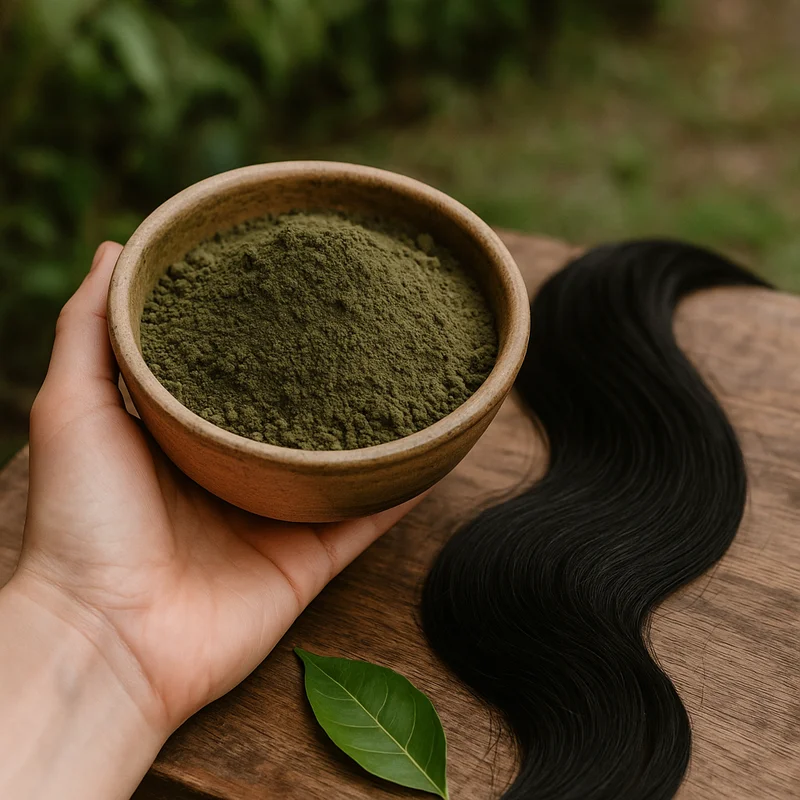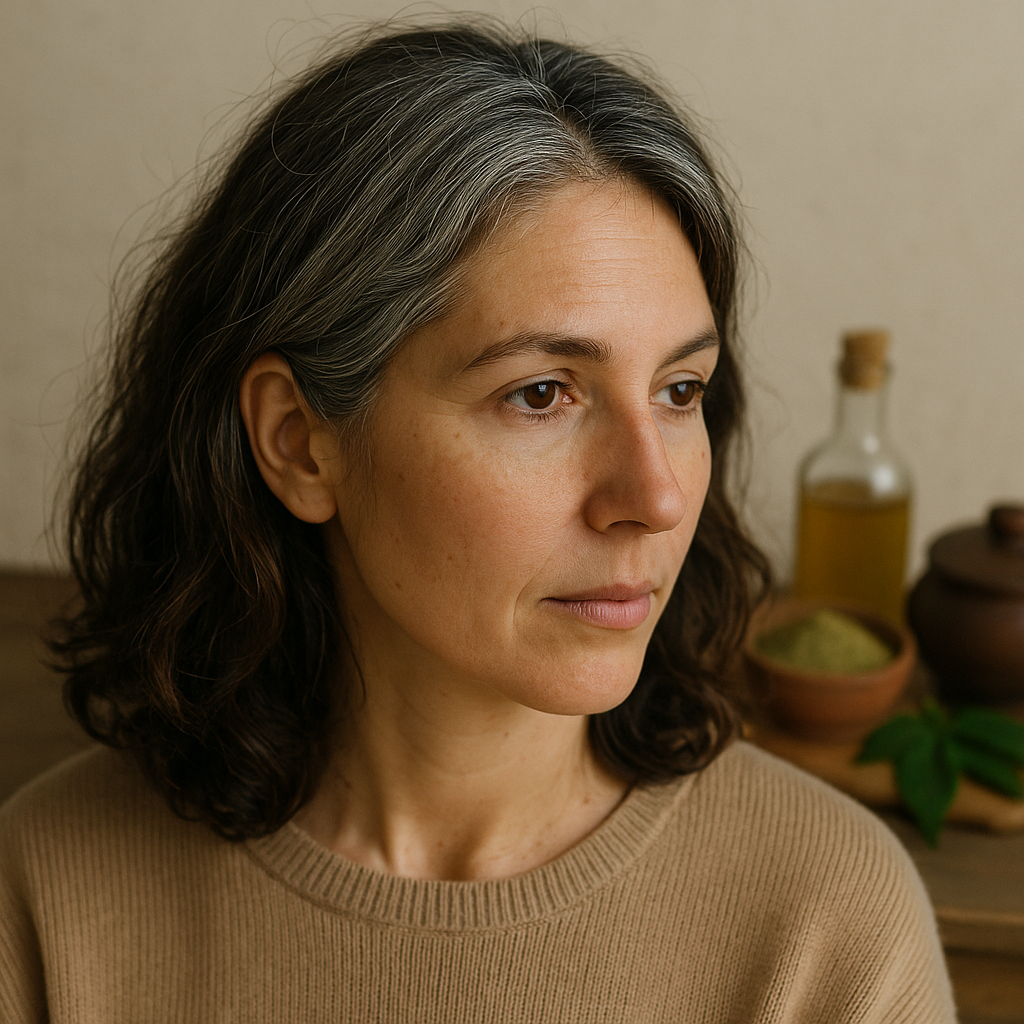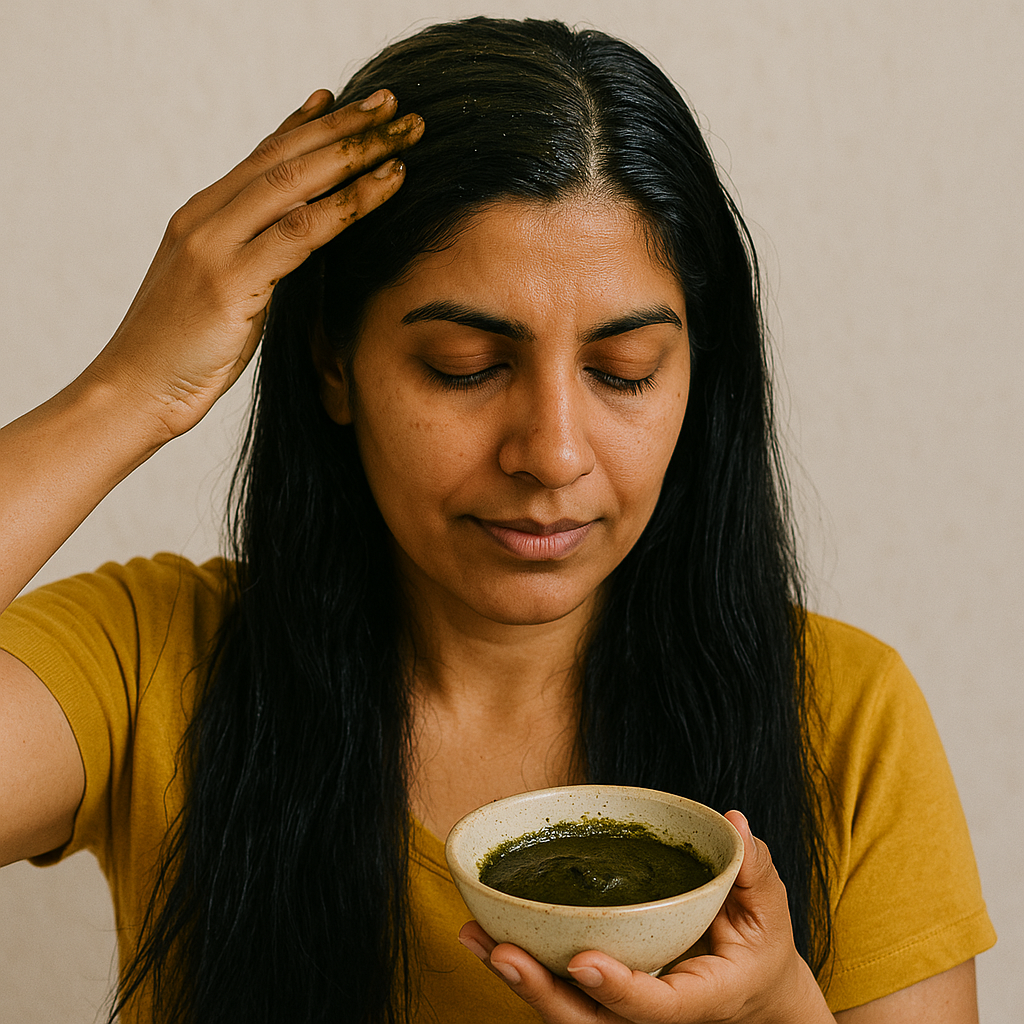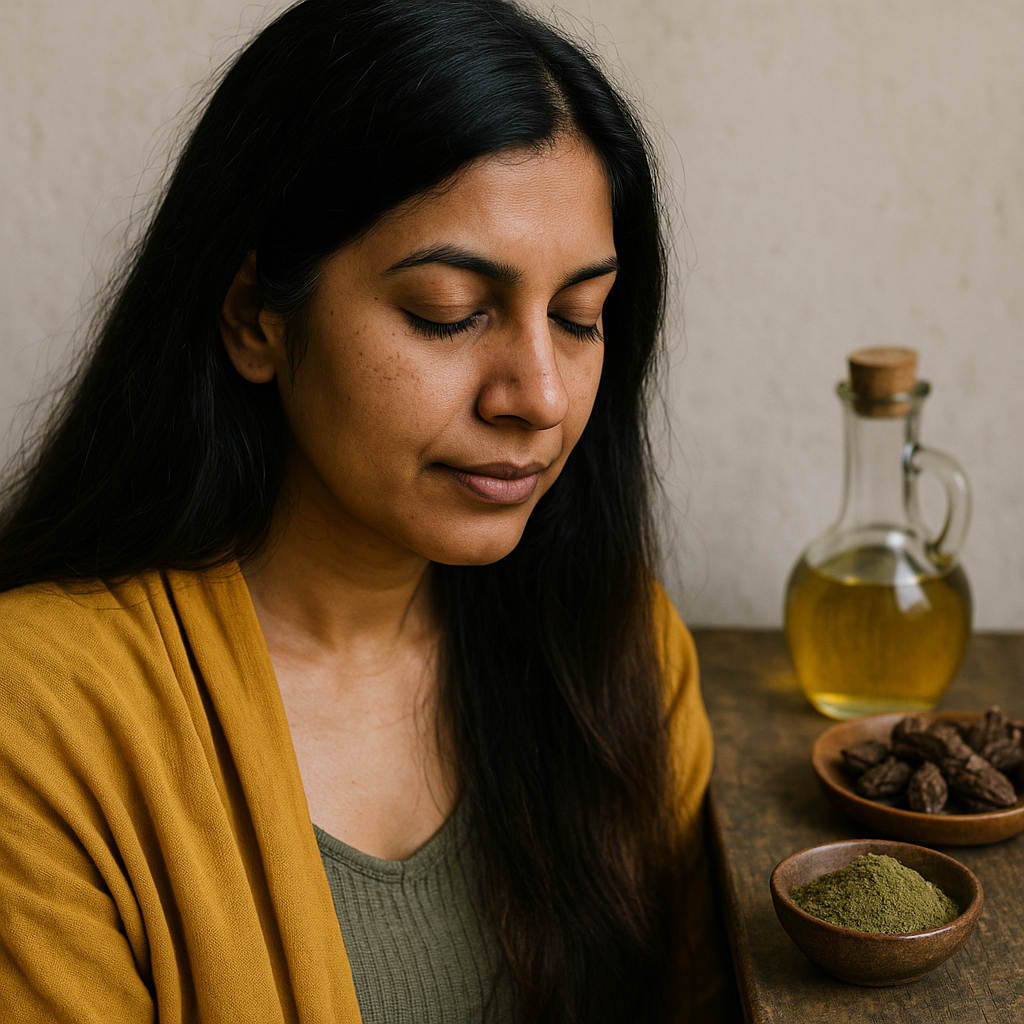Ask Ayurvedic doctor a question and get a consultation online on the problem of your concern in a free or paid mode. More than 2,000 experienced doctors work and wait for your questions on our site and help users to solve their health problems every day.
Shop Now in Our Store
Ayurvedic Hair Dye Black: Natural Color, Ancient Wisdom

Introduction
So, I’ve got a confession to make — I used to really stress about my hair turning gray. Not in a midlife-crisis kind of way, but every time I looked in the mirror, the silvery strands caught my eye like little traitors. I tried every off-the-shelf hair dye imaginable. You name it: chemical dyes, ammonia-free, organic-sounding stuff... all with mixed results — and let’s not even talk about the allergic reaction I had to one brand. That’s when someone — my aunt, of all people — handed me a jar of something earthy, homemade-looking, and said, “Try this. It's ayurvedic.”
That’s how I stumbled into the world of ayurvedic hair dye black — and I haven’t looked back.
Now, if you’re hearing about this for the first time, you might wonder: what is it? Is it just henna? Does it actually work? And what’s so Ayurvedic about it, anyway?
Well, that’s what we’re going to explore here. Because ayurvedic black hair dye isn’t just about covering up gray — it’s about restoring balance, using time-tested herbs, and doing it in a way that your body actually thanks you for. It's like the complete opposite of that choking chemical cloud you get in a salon. This is earthy, grounding, even meditative.
And in Ayurveda — India’s ancient, holistic system of medicine — hair color isn’t just cosmetic. It’s tied to internal health, liver function, the condition of your blood, and yes, your dosha. (We'll get into that.)
So whether you're looking for a safer alternative, curious about Ayurvedic beauty rituals, or deep into natural wellness and want to know how your hair fits into the bigger healing picture — this guide is for you.
Let’s dig in.

What is Ayurvedic Hair Dye Black?
Definition and Origin of Ayurvedic Hair Dye Black
Okay, so let’s set the record straight: Ayurvedic hair dye black isn’t one single substance. It’s more like a category — a blend of naturally derived, plant-based ingredients used to color hair black, grounded in Ayurvedic traditions. The core idea? Use herbs and minerals that nourish your scalp, balance your body’s energies (yes, doshas again), and gently tint the hair — all without causing harm.
Commonly used ingredients include:
-
Indigo (Indigofera tinctoria) – the real powerhouse behind the black color.
-
Henna (Lawsonia inermis) – provides a reddish base that helps the indigo bind better.
-
Amla (Indian gooseberry) – for scalp health, shine, and preventing premature graying.
-
Bhringraj – another all-star herb that supports hair growth and pigmentation.
Unlike chemical dyes, which force color change through oxidation and harsh agents, Ayurvedic dyes coat the hair in pigment, leaving it stronger and shinier.
And no — it doesn’t smell like a salon. It smells like earth, like rain on dry soil, like… well, like something real.
Historical Use of Ayurvedic Hair Dye Black in Ayurveda
You’d be surprised how much the ancients were obsessed with their hair. Ancient Ayurvedic texts, especially the Charaka Samhita and Sushruta Samhita, reference various herbs used for restoring hair color and treating graying, hair loss, and scalp diseases.
Indigo and henna aren’t just cosmetic in these texts — they’re medicinal. Amla was praised for its rasayana (rejuvenating) properties. Hair was considered a reflection of your ojas — your vitality. So premature graying? A red flag.
In royal courts across India, herbal concoctions were massaged into the scalp not just for beauty, but to support inner balance. Think of it like a head spa with a metaphysical twist.
There’s even this old belief that graying starts when your pitta dosha (fire and transformation) goes out of whack — overheated blood, overthinking, spicy food — it all adds up. And Ayurvedic hair dye was the gentle fix.
Cultivation and Harvesting Details (If Applicable)
This part is oddly satisfying to know: the herbs used in Ayurvedic black hair dye are mostly cultivated using organic, traditional farming techniques. Especially indigo and henna, which grow best in dry, arid zones — like Rajasthan, Gujarat, and parts of South India.
-
Henna is harvested by cutting the shrub branches just before flowering, drying them, and grinding into powder.
-
Indigo needs a fermentation process — the leaves are soaked and oxidized to develop the deep blue-black pigment.
Farmers often still use time-honored methods — no pesticides, no artificial drying. There’s even a rhythm to when the plants are harvested (following moon cycles, in some cases — yes, really).
And here’s something personal: the first time I mixed henna and indigo at home, it felt more like cooking than dying. A little messy, sure, but weirdly therapeutic. Stirring something ancient into warm water, watching it bloom into color… that’s magic right there.
Key Components and Active Substances in Ayurvedic Hair Dye Black
Chemical Composition and Active Ingredients
Now, I’m no chemist — and I suspect you aren’t either — but let’s geek out a little. Because once you understand why these herbs work, the whole Ayurvedic approach just makes more sense.
Here’s a peek inside the herbal toolbox:
-
Indigo (Indigofera tinctoria) – The star of the show. It contains indigotin, a deep blue dye molecule that, when applied after henna, creates a rich black tone. Alone? It’s kind of blue. But paired correctly — magic.
-
Henna (Lawsonia inermis) – This one's rich in lawsone, a molecule that binds with keratin (your hair’s main protein) and stains it reddish-orange. Essential for helping indigo stick.
-
Amla (Phyllanthus emblica) – Loaded with vitamin C and antioxidants. It supports melanin production, strengthens follicles, and boosts natural shine.
-
Bhringraj (Eclipta alba) – Traditionally used for reversing premature graying. Contains compounds like wedelolactone that support scalp health.
-
Brahmi, Neem, Shikakai – Sometimes added to boost scalp detox, fight dandruff, or enhance texture.
There's a kind of elegant simplicity here — you're not just dyeing your hair; you're delivering plant medicine straight to the scalp.
How the Components Affect the Body
Ayurveda doesn’t just treat symptoms — it goes upstream, to the root cause. That’s why even something like hair dye is meant to nourish the whole system.
Let’s break it down:
-
Indigo cools the scalp. Great for pitta-dominant folks who run hot and may gray early due to internal heat.
-
Amla supports liver health and purifies blood — both believed to influence hair pigmentation.
-
Henna has antimicrobial and anti-inflammatory effects. Also a natural conditioner (ask anyone who’s used it — the softness is unreal).
-
Bhringraj is thought to rejuvenate not just the scalp but the nervous system — calming vata imbalance that contributes to dryness and hair fall.
In short, you’re not just coloring — you’re balancing. Nourishing. Resetting.
Comparison with Similar Ayurvedic Remedies
You could go for straight henna, of course — it’s great for reddish tones and scalp health. But if you want black, that’s where indigo comes in. And not on its own — the classic method is two-step: henna first, then indigo.
Other options people try:
-
Synthetic "herbal" dyes: Marketed as “Ayurvedic” but often sneak in chemicals. Read the label!
-
Cassia: A neutral henna that doesn’t color much, but can add body and shine.
-
Katha and Walnut husk: Used in traditional blends to deepen color.
But really — the henna+indigo duo is the gold standard for deep, natural black.

Health Benefits and Therapeutic Uses of Ayurvedic Hair Dye Black
Physical Health Benefits
Now here’s the part I didn’t expect — I came for the color, but stayed for the benefits. Because Ayurvedic hair dye isn’t just safer, it’s actively good for you.
-
Scalp health: Ingredients like neem, amla, and henna are antimicrobial, anti-fungal, and cooling. They help with dandruff, itching, and even minor infections.
-
Hair strength: Coats each strand, reducing breakage. You feel it after just one use — this deep, smooth strength.
-
Slows graying: Repeated use, especially with herbs like bhringraj and amla, can slow down the loss of pigment over time. (No miracles, but better than chemicals speeding things up!)
-
No harsh reactions: For people with dye allergies or scalp sensitivity, this stuff is often the only safe option. No ammonia. No peroxide.
Honestly, for those of us tired of trading short-term beauty for long-term damage — it’s a relief.
Mental and Emotional Health Benefits
This is where things get a little fuzzy — in a good way.
There’s something inherently ritualistic about mixing the powder, applying it, and sitting still with a mud mask on your head for an hour or two. It slows you down. You breathe. You notice your body. Your scalp.
And in Ayurveda, that's no small thing. Every oil, every herb, every touch — it’s supposed to bring you into yourself.
Some folks report better sleep after a head massage with dye herbs. Some feel emotionally calmer, less scattered. Is that placebo? Maybe. But also — maybe not.
Most Effective Use Cases
Here’s where Ayurvedic black dye shines:
-
People with premature graying in their 20s–30s, especially pitta types.
-
Those with dye allergies or scalp conditions triggered by conventional products.
-
Postpartum hair loss cases — the herbs are gentler and more nurturing.
-
People recovering from stress or illness, who want to avoid chemical load.
Bonus? Great for men, too. Beards, mustaches — works the same way. (Yes, it might smell a little herbal, but that fades quickly.)
Use of Ayurvedic Hair Dye in Integrated Ayurvedic Therapy
This might sound like overkill, but Ayurvedic practitioners sometimes recommend herbal dyes as part of a whole system treatment.
Graying or hair fall might lead to questions like:
-
How’s your digestion?
-
Are you sleeping well?
-
What’s your stress level like?
So they might pair topical dye with:
-
Amla supplements or chyawanprash
-
Nasya oil treatments
-
Shirodhara or scalp massages with bhringraj oil
You’re not just covering gray — you’re resetting your body’s rhythm.
Indications and Contraindications of Ayurvedic Hair Dye Black
Health Conditions Where It's Recommended
Here’s when Ayurvedic black dye is actually advised, not just allowed:
-
Premature graying from stress, heat, or nutrient deficiency.
-
Dandruff or scalp irritation that flares with chemical products.
-
Hair thinning due to hormonal imbalance, digestive issues, or pitta/vata disturbance.
-
Post-illness recovery where natural nourishment is key.
Some Ayurvedic practitioners even use these herbs alongside internal treatments for anemia, liver issues, or hormonal shifts — because hair is never just about hair.
Possible Side Effects and Contraindications
That said — just because it’s natural doesn’t mean it’s always perfect.
-
Indigo sensitivity is rare but real. It can cause itching or rash if your body doesn’t agree with it.
-
Henna overuse can dry out the hair over time. That’s why some people mix it with oils or conditioners.
-
Color unpredictability — especially the first few times. You might get brown, burgundy, or blue-black depending on your hair’s condition.
Pro tip: always do a strand test. Always.
Restrictions Based on Age, Health Status, or Drug Interactions
Generally, Ayurvedic hair dyes are safe for:
-
Teens
-
Pregnant women (though always worth double-checking)
-
Elderly folks with fragile scalps
But proceed with caution if:
-
You have active scalp wounds or infections
-
You’re on heavy immunosuppressants
-
You’ve had allergic reactions to plants like indigo or henna
And yeah — it’s always worth talking to an Ayurvedic practitioner. Especially if you're using other herbal meds or have health conditions that mess with your skin or blood.
How to Properly Use Ayurvedic Hair Dye Black
Recommended Forms and Dosages
Most come in powder form — because it keeps the herbs potent.
You’ll usually see:
-
Pure Henna
-
Pure Indigo
-
Pre-mixed herbal dyes (read the labels!)
Standard quantity:
-
Short hair: 50–75g
-
Medium hair: 100g
-
Long hair: 150–200g
Mix with warm water (or tea, or coffee, or even aloe juice — depends who you ask). Let it rest for 30–60 mins. Apply to clean, dry hair.
Leave on for 1–2 hours. Rinse. No shampoo for 24–48 hours to let the color set.
Best Time to Take It / Dosage Schedule
Ayurveda being Ayurveda, timing matters:
-
Daytime application is preferred — ideally morning to midday, when pitta is naturally higher.
-
Avoid cold, rainy days (herbs might not bind well).
-
Don’t apply during your period if you tend to feel weak — the cooling herbs might make you feel chilly.
Frequency:
-
Every 3–6 weeks depending on hair growth and color fade.
-
Some use henna monthly and indigo only every second month.
Recipes and Practical Advice
Here’s a basic home method I swear by:
-
Day before: Oil your hair lightly.
-
Step 1: Mix henna with warm black tea and a squeeze of lemon. Let it sit overnight.
-
Morning: Apply henna. Wrap your head in a shower cap. Wait 1–2 hours. Rinse.
-
Step 2: Mix indigo with warm water and a pinch of salt. Let sit 10 mins. Apply over hennaed hair. Wait 1–2 hours. Rinse.
Yes, it’s a commitment. No, you won’t regret it.
Pro tip? Always keep an old towel handy. And maybe warn your roommates about the "herbal mud monster" look.

Success Stories and Real-Life Examples (Case Studies)
I’ll be honest: I used to think “testimonials” were mostly marketing fluff. But in the world of Ayurveda — where things move slower, deeper — real stories actually matter.
Case 1: A Software Engineer with an Itchy Scalp and Premature Graying
Ravi, 34, had been graying since his late 20s. Long hours, erratic meals, and a high-pressure tech job had done a number on him. He tried drugstore dyes, but every time, his scalp broke out in tiny blisters.
On his Ayurvedic doctor’s advice, he switched to a two-step henna and indigo process, with a little amla mixed in. The color was deep, consistent, and — no itching. After six months of monthly use, plus some dietary tweaks (goodbye, excess coffee), his new growth was darker, shinier. Not dramatic — but real.
He told me: "I didn't even realize how stressed my scalp had been until it stopped screaming at me."
Case 2: A New Mom with Postpartum Hair Loss
Meera, 29, loved coloring her hair jet black before her baby arrived. But postpartum, everything changed — her hair started falling in clumps. She was afraid to go near dyes again.
Her Ayurvedic doula recommended a blend of henna, bhringraj, and indigo, used once every six weeks. Alongside warm oil massages, she began noticing her hair was not only stronger but had regained its luster — that “healthy black” she missed.
She called it her “crown of calm.”
These stories might sound simple — but in a world of quick fixes and harsh formulas, their quiet success feels revolutionary.
Scientific Research and Evidence of Effectiveness of Ayurvedic Hair Dye Black
Summary of Clinical Studies Supporting Ayurvedic Hair Dye
Let’s be honest: Ayurvedic herbs haven’t been studied as extensively as pharmaceuticals — but that’s changing.
Here’s what the research shows so far:
-
Henna (Lawsonia inermis): Studies confirm its antifungal, antibacterial, and antioxidant properties. Some even explore its effect on scalp psoriasis and dermatitis.
-
Indigofera tinctoria: Limited studies exist, but it’s been documented to contain anti-inflammatory compounds and is used in traditional medicine for liver and skin health — indirectly related to hair pigmentation.
-
Amla (Phyllanthus emblica): Well-studied in Ayurvedic medicine. Known for its high vitamin C, it’s been linked to improved hair density, shine, and reduced oxidative stress.
One 2021 comparative study in an Indian journal tested herbal hair dyes against synthetic ones — and found the former scored better in scalp compatibility, long-term hair texture, and user satisfaction. Yes, the color faded faster, but health outcomes improved.
References to Medical Journals and Research Papers
-
Indian Journal of Traditional Knowledge (IJTK) – Articles on Amla and Henna usage in dermatology.
-
Journal of Ethnopharmacology – Published studies on Indigofera’s medicinal use.
-
International Journal of Cosmetic Science – Articles exploring consumer safety in hair dyes, comparing synthetic and herbal options.
Is this Nobel Prize-winning research? No. But the trend is clear: the scientific community is waking up to what Ayurveda has quietly known for centuries.
Comparison with Results from Conventional Medicine
Here’s the rub: conventional hair dyes work fast, cover gray in one go, and last longer. But they come with trade-offs:
-
Ammonia and PPD — known irritants and allergens.
-
Repeated exposure — linked to scalp sensitivity, follicle damage, and in rare cases, more serious health issues.
-
Cumulative toxicity — especially for people who dye frequently.
Ayurvedic hair dye isn’t about instant perfection — it’s about steady restoration. The shine might take time. The black might need a couple of rounds. But your scalp? It’ll thank you. So will your liver.
Conclusion
So, what’s the deal with ayurvedic hair dye black?
It's not a miracle product. It doesn’t promise eternal youth or perfect Pinterest hair. What it does offer is something much rarer these days: gentleness. Integrity. A way to color your hair that doesn’t punish your scalp or throw your body out of balance.
It’s earthy. It’s ancient. And yeah — it’s a little messy. But there’s something powerful about reclaiming this ritual, about taking two hours to sit with your roots (literally and metaphorically), about honoring your body’s rhythms.
Whether you're gray at 25 or 55, allergic to dye, or just curious — Ayurveda doesn’t just cover up signs of age. It offers a deeper way to engage with them.
So if you’re ready to ditch the chemicals, slow things down, and maybe — just maybe — fall back in love with your hair?
Try ayurvedic hair dye black.
👉 Get personalized advice about ayurvedic hair dye black
Frequently Asked Questions (FAQ)
1. Will Ayurvedic hair dye black turn my hair jet black?
Not always — results vary depending on your original color, how you prep the dye, and how many applications you do. But with consistent two-step use (henna + indigo), you can get a deep, natural black over time.
2. Is it safe to use during pregnancy?
Generally yes, especially compared to chemical dyes. But always check with your healthcare provider first — especially if you’ve had allergic reactions to herbs before.
3. How long does the color last?
Usually 3–6 weeks. It fades more gradually than chemical dyes and often looks more natural as it goes. Regular oiling helps the color last longer.
4. Can I mix Ayurvedic dyes with conditioner or oil?
Henna — no. It needs an acidic base and clean hair to bind. Indigo — sometimes, yes. Adding a bit of aloe or oil can soften the texture, but it may dilute the color.
5. What if I want to switch back to chemical dye later?
Give it time. Wait at least 4–6 weeks and test a strand first. Some chemical dyes can react weirdly with plant-based layers (think odd colors or dryness). Better to consult a stylist familiar with natural dyes.
This article is checked by the current qualified Dr Sujal Patil and can be considered a reliable source of information for users of the site.

